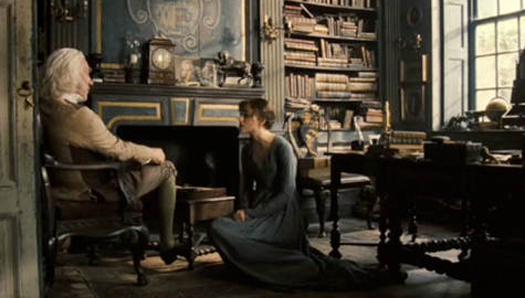

Pride & Prejudice (2005) dir. Joe Wright (via Design*Sponge, "Living In: Pride and Prejudice")
Yesterday Twitter told me that Persuasion was the best of Jane Austen's novels. This made me pause. Did I agree? Pride and Prejudice is my favorite, the one I re-read every year, the one quoted on my marriage certificate, the one I borrowed the VHS tapes of the BBC miniseries of and never returned. Couldn't Elizabeth Bennet be an architecture critic? But yes, I thought, Persuasion is the best. It is sad. One has to consider whether one has also lost one's bloom. But it has lovely people in it, and the climax is a scene of such suppressed tension it is a wonder one can recover in time for the happy ending.
That doesn't count as a spoiler, does it?
I had been thinking about Austen again lately because she turned up on the lists of several designers I admire on Designers & Books. Whenever I peruse the site I am always making up my own book list in my head, and P&P was definitely on it. But why do designers like Austen? Michael Sorkin calls it "precise" and that is definitely part of it. You don't feel as if she had a messy dressing table, and probably never left a pen unwiped.
So I started to make a list.
1. Architecture plays a part. Literary critics are always talking about money in Austen, but real estate is just as important. In Persuasion Anne Elliot is in Bath, and not at home in the country like a proper baronet's daughter because the baronet has run out of funds. Emma always gets into trouble when she leaves her own house. Is a cottage romantic or a last resort? Ten thousand a year is nice, but an estate is definitely better.
In P&P there is the famous and much-debated remark of Elizabeth's. Her beautiful/dull sister Jane asks her what caused her change of feeling about Mr. Darcy. And she says: "But I believe I must date it from my first seeing his beautiful grounds at Pemberley."
In the BBC P&P Jennifer Ehle delivers this line with the perfect rosebud smirk.
2. Rooms = ritual. No one ever says what they mean in Austen because they are never alone. They move from room to room throughout the day, doing the task that is performed in that room every day. In Bath, one is expecting Anne to feel more free, but she finds that Bath is just a series of outdoor rooms, in which people perform a different set of tasks: taking the waters, attending a concert, giving a reception. Like the symmetrical, proscribed dances that always feature prominently in Austen films, if one isn't thinking one could just be led around by the buildings all the time.
It is heretical to say you liked anything about Joe Wright's P&P with Keira Knightley, but I thought his frontal camera work was intended to suggest that all the human interactions had set steps. He sets all the emotional scenes outdoors, where the walls aren't pushing the characters around.
3. The precision thing. Austen is like a puppeteer. Or an art director. The recent kerfuffle about the unsatisfying ending to The Killing revealed an important truth about keeping your audience happy: they want to know that you know where you are going. There is never a question with Austen that each scene is there for a reason, each character is going to play their part, and that the novel will finally be finished. Maybe that makes it a little schematic, but so is architecture.
Now that I have written this out, I should choose something else for my hypothetical list, and I have just the thing. Edith Wharton's Custom of the Country. Our heroine really does marry for the house.
